Hyundai H 1 Grand Starex 2015, H 1 Grand Starex 2014 Owner's Manual
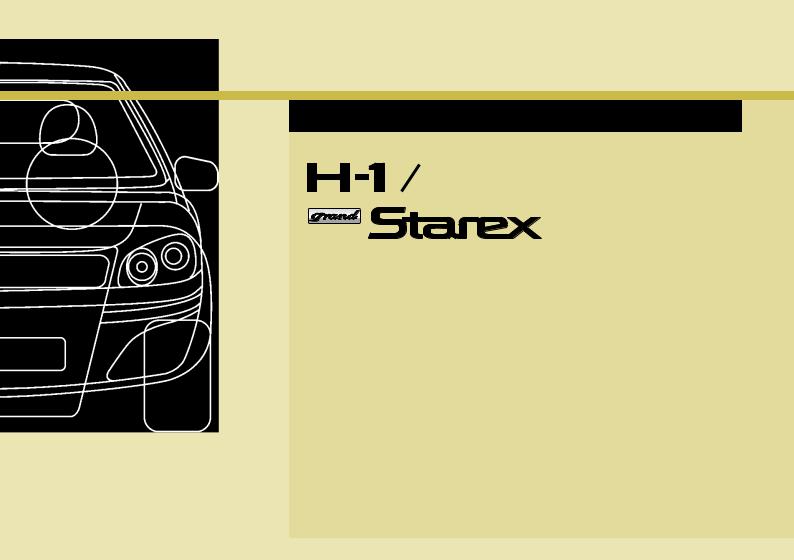
OWNER'S MANUAL
Operation
Maintenance
Specifications
All information in this Owner's Manual is current at the time of publication. However, Hyundai reserves the right to make changes at any time so that our policy of continual product improvement may be carried out.
This manual applies to all models of this vehicle and includes descriptions and explanations of optional as well as standard equipment. As a result, you may find material in this manual that does not apply to your specific vehicle.
Please note that some models are equipped with Right-Hand Drive (RHD). The explanations and illustrations for some operations in RHD models are opposite of those written in this manual.
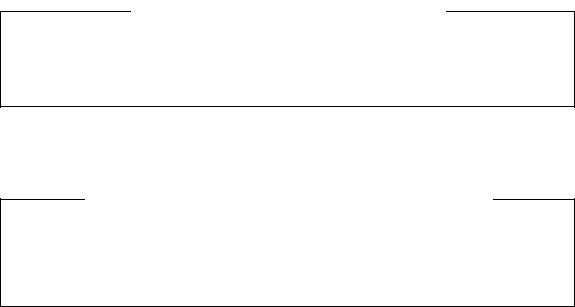
CAUTION: MODIFICATIONS TO YOUR HYUNDAI
Your Hyundai should not be modified in any way. Such modifications may adversely affect the performance, safety or durability of your Hyundai and may, in addition, violate conditions of the limited warranties covering the vehicle. Certain modifications may also be in violation of regulations established by the Department of Transportation and other government agencies in your country.
TWO-WAY RADIO OR CELLULAR TELEPHONE INSTALLATION
Your vehicle is equipped with electronic fuel injection and other electronic components. It is possible for an improperly installed/adjusted two-way radio or cellular telephone to adversely affect electronic systems. For this reason, we recommend that you carefully follow the radio manufacturer's instructions or consult your Hyundai dealer for precautionary measures or special instructions if you choose to install one of these devices.
F2
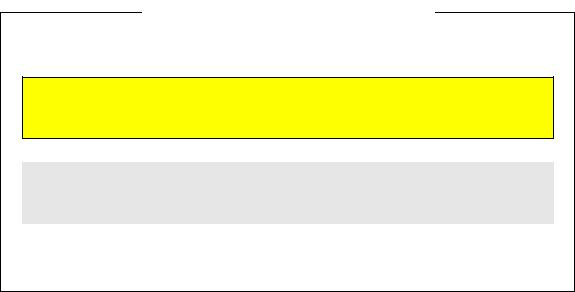
SAFETY AND VEHICLE DAMAGE WARNING
This manual includes information titled as WARNING, CAUTION and NOTICE.
These titles indicate the following:
 WARNING
WARNING
This indicates that a condition may result in harm, serious injury or death to you or other persons if the warning is not heeded. Follow the advice provided with the warning.
 CAUTION
CAUTION
This indicates that a condition may result in damage to your vehicle or its equipment if the caution is not heeded. Follow the advice provided with the caution.
NOTICE
This indicates that interesting or helpful information is being provided.
F3
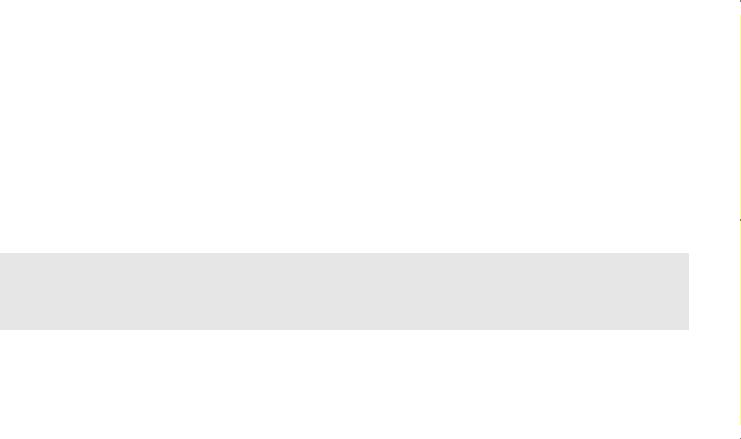
FOREWORD
Thank you for choosing Hyundai. We are pleased to welcome you to the growing number of discriminating people who drive Hyundais. The advanced engineering and high-quality construction of each Hyundai we build is something of which we're very proud.
Your Owner's Manual will introduce you to the features and operation of your new Hyundai. It is suggested that you read it carefully because the information it contains can contribute greatly to the satisfaction you receive from your new car.
The manufacturer also recommends that service and maintenance on your vehicle be performed by an authorized Hyundai dealer.
HYUNDAI MOTOR COMPANY
Note : Because future owners will also need the information included in this manual, if you sell this Hyundai, please leave the manual in the vehicle for their use. Thank you.
 CAUTION
CAUTION
Severe engine and transmission damage may result from the use of poor quality fuels and lubricants that do not meet Hyundai specifications. You must always use high quality fuels and lubricants that meet the specifications listed on Page 9-4 in the Vehicle Specifications section of the Owner's Manual.
Copyright 2014 Hyundai Motor Company. All rights reserved. No part of this publication may be reproduced, stored in any retrieval system or transmitted in any form or by any means without the prior written permission of Hyundai Motor Company.
F4

|
|
|
|
|
|
|
|
|
Introduction |
|
1 |
|
|
|
|
|
|
|
|
|
Your vehicle at a glance |
|
2 |
|
|
|
|
|
|
|
|
|
Safety features of your vehicle |
|
3 |
|
|
|
|
|
|
|
|
|
Features of your vehicle |
|
4 |
|
|
|
|
|
|
table of contents |
|
|
Driving your vehicle |
|
5 |
|
|
||||
|
|
|
|
|
|
|
|
|
What to do in an emergency |
|
6 |
|
|
|
|
|
|
|
|
|
Maintenance |
|
7 |
|
|
|
|
|
|
|
|
|
Consumer information |
|
8 |
|
|
|
|
|
|
|
|
|
Specifications |
|
9 |
|
|
|
|
|
|
|
|
|
Index |
|
I |
|
|
|
|
|
|
|
|
|
|
|
|
|
|
|
|
|
|

Introduction |
|
1 |
How to use this manual / 1-2
Fuel requirements / 1-2
Vehicle handling instructions / 1-6
Vehicle break-in process / 1-6
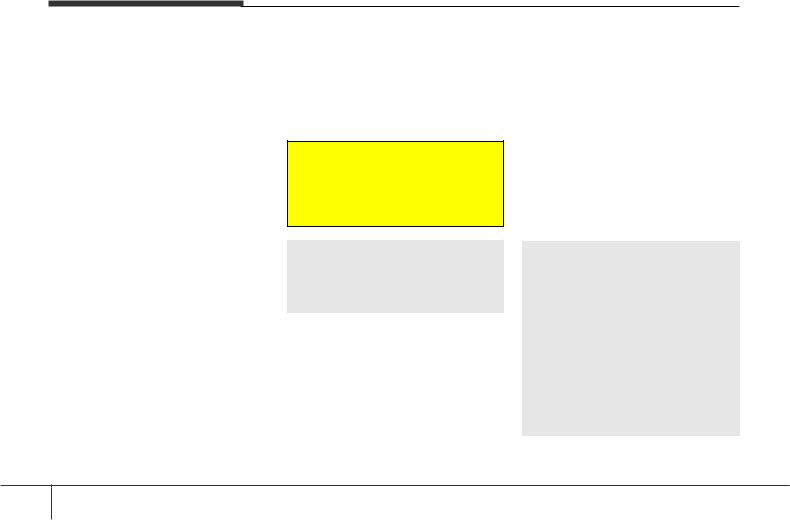
Introduction
HOW TO USE THIS MANUAL
A010000AUN
We want to help you get the greatest possible driving pleasure from your vehicle. Your Owner’s Manual can assist you in many ways. We strongly recommend that you read the entire manual. In order to minimize the chance of death or injury, you must read the WARNING and CAUTION sections in the manual.
Illustrations complement the words in this manual to best explain how to enjoy your vehicle. By reading your manual, you learn about features, important safety information, and driving tips under various road conditions.
The general layout of the manual is provided in the Table of Contents. A good place to start is the index; it has an alphabetical listing of all information in your manual.
Sections: This manual has nine sections plus an index. Each section begins with a brief list of contents so you can tell at a glance if that section has the information you want.
You will find various WARNINGs, CAUTIONs, and NOTICEs in this manual. These WARNINGs were prepared to enhance your personal safety. You should carefully read and follow ALL procedures and recommendations provided in these WARNINGs, CAUTIONs and NOTICEs.
 WARNING
WARNING
A WARNING indicates a situation in which harm, serious bodily injury or death could result if the warning is ignored.
 CAUTION
CAUTION
A CAUTION indicates a situation in which damage to your vehicle could result if the caution is ignored.
NOTICE
A NOTICE indicates interesting or helpful information is being provided.
FUEL REQUIREMENTS
Gasoline engine
A020101AEN
Unleaded
Your new HYUNDAI vehicle is designed to use only unleaded fuel having an Octane Rating of RON (Research Octane Number) 91/AKI (Anti-Knock Index) 87 or higher. (Do not use methanol blended fuels.)
Your new vehicle is designed to obtain maximum performance with UNLEADED FUEL, as well as minimize exhaust emissions and spark plug fouling.
 CAUTION
CAUTION
NEVER USE LEADED FUEL. The use of leaded fuel is detrimental to the catalytic converter and will damage the engine control system’s oxygen sensor and affect emission control.
Never add any fuel system cleaning agents to the fuel tank other than what has been specified. (We recommend that the system be consulted by an authorized HYUNDAI dealer.
1 2

Introduction
 WARNING
WARNING
•Do not "top off" after the nozzle automatically shuts off when refueling.
•Always check that the fuel cap is installed securely to prevent fuel spillage in the event of an accident.
A020102AEN
Leaded (if equipped)
For some countries, your vehicle is designed to use leaded gasoline. When you are going to use leaded gasoline, we recommend that you ask an authorized HYUNDAI dealer.
Octane Rating of leaded gasoline is same with unleaded one.
A020103AUN
Gasoline containing alcohol and methanol
Gasohol, a mixture of gasoline and ethanol (also known as grain alcohol), and gasoline or gasohol containing methanol (also known as wood alcohol) are being marketed along with or instead of leaded or unleaded gasoline.
Do not use gasohol containing more than 10% ethanol, and do not use gasoline or gasohol containing any methanol. Either of these fuels may cause drivability problems and damage to the fuel system, engine control system and emission control system.
Discontinue using gasohol of any kind if drivability problems occur.
Vehicle damage or drivability problems may not be covered by the manufacturer’s warranty if they result from the use of:
1.Gasohol containing more than 10% ethanol.
2.Gasoline or gasohol containing methanol.
3.Leaded fuel or leaded gasohol.
 CAUTION
CAUTION
Never use gasohol which contains methanol. Discontinue use of any gasohol product which impairs drivability.
Other fuels
Using fuels such as;
-Silicone (Si) contained fuel,
-MMT (Manganese, Mn) contained fuel,
-Ferrocene (Fe) contained fuel, and
-Other metalic additives contained fuels,
may cause vehicle and engine damage or cause plugging, misfiring, poor acceleration, engine stalling, catalyst melting, abnormal corrosion, life cycle reduction, etc.
Also, the Malfunction Indicator Lamp (MIL) may illuminate.
NOTICE
Damage to the fuel system or performance problem caused by the use of these fuels may not be covered by your New Vehicle Limited Warranty.
1 3
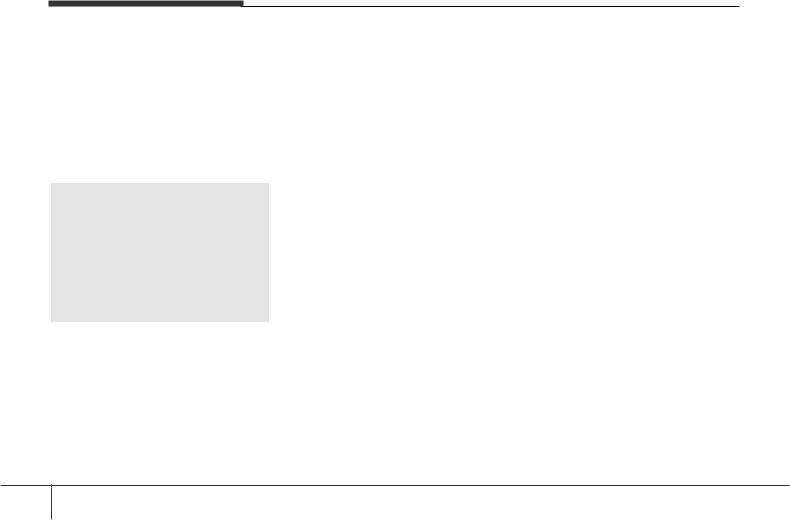
Introduction
A020104AEN
Use of MTBE
HYUNDAI recommends avoiding fuels containing MTBE (Methyl Tertiary Butyl Ether) over 15.0% vol. (Oxygen Content 2.7% weight) in your vehicle.
Fuel containing MTBE over 15.0% vol. (Oxygen Content 2.7% weight) may reduce vehicle performance and produce vapor lock or hard starting.
 CAUTION
CAUTION
Your New Vehicle Limited Warranty may not cover damage to the fuel system and any performance problems that are caused by the use of fuels containing methanol or fuels containing MTBE (Methyl Tertiary Butyl Ether) over 15.0% vol. (Oxygen Content 2.7% weight.)
A020105AUN
Do not use methanol
Fuels containing methanol (wood alcohol) should not be used in your vehicle. This type of fuel can reduce vehicle performance and damage components of the fuel system, engine control system and emission control system.
Fuel Additives
HYUNDAI recommends that you use unleaded gasoline which has an octane rating of RON(Research
Octane Number) 95 / AKI (Anti Knock Index) 91 or higher (for Europe) or Octane Rating of RON (Research Octane Number) 91 / AKI (Anti-Knock Index) 87 or higher (except Europe).
For customers who do not use good quality gasoline including fuel additives regularly, and have problems starting or the engine does not run smoothly, one bottle of additives added to the fuel tank at every 15,000km (for Europe)/5,000km (except Europe). Additives are available from your authorized HYUNDAI dealer along with information on how to use them.
A020107AUN
Operation in foreign countries
If you are going to drive your vehicle in another country, be sure to:
•Observe all regulations regarding registration and insurance.
•Determine that acceptable fuel is available.
Diesel engine
A020201DUN
Diesel fuel
Diesel engine must be operated only on commercially available diesel fuel that complies with EN 590 or comparable standard. (EN stands for "European Norm").
Do not use marine diesel fuel, heating oils, or non-approved fuel additives, as this will increase wear and cause damage to the engine and fuel system.
The use of non-approved fuels and/or fuel additives will result in a limitation of your warranty rights.
Diesel fuel of above cetane 51 is used in your vehicle. If two types of diesel fuel are available, use summer or winter fuel properly according to the following temperature conditions.
•Above -5°C (23°F) ... Summer type diesel fuel.
•Below -5°C (23°F) ... Winter type diesel fuel.
Watch the fuel level in the tank very carefully : If the engine stops through fuel failure, the circuits must be completely purged to permit restarting.
1 4
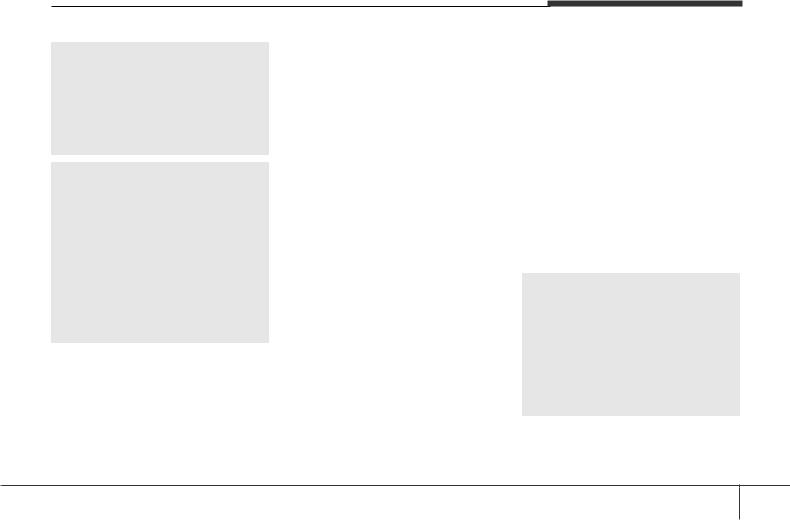
 CAUTION
CAUTION
Do not let any gasoline or water enter the tank. This would make it necessary to drain it out and to bleed the lines to avoid jamming the injection pump and damaging the engine.
CAUTION - Diesel Fuel (if equipped with DPF)
It is recommended to use the regulated automotive diesel fuel for diesel vehicle equipped with the DPF system.
If you use diesel fuel including high sulfur (more than 50 ppm sulfur) and unspecified additives, it can cause the DPF system to be damaged and white smoke can be emitted.
Introduction
A020202BUN
Biodiesel
Commercially supplied Diesel blends of no more than 7% biodiesel, commonly known as "B7 Diesel" may be used in your vehicle if Biodiesel meets EN 14214 or equivalent specifications. (EN stands for "European Norm"). The use of biofuels exceeding 7% made from rapeseed methyl ester (RME), fatty acid methyl ester (FAME), vegetable oil methyl ester (VME) etc. or mixing diesel exceeding 7% with biodiesel will cause increased wear or damage to the engine and fuel system. Repair or replacement of worn or damaged components due to the use of non approved fuels will not be covered by the manufactures warranty.
A020202AUN
Biodiesel (for New Zealand)
Commercially supplied Diesel blends of no more than 7% biodiesel, commonly known as "B7 Diesel" may be used in your vehicle if Biodiesel meets EN 14214 or equivalent specifications. (EN stands for "European Norm"). The use of biofuels exceeding 7%, made from rapeseed methyl ester (RME), vegetable oil methyl ester (VME) etc. or mixing diesel exceeding 7% with biodiesel will cause increased wear or damage to the engine and fuel system. Repair or replacement of worn or damaged components due to the use of non approved fuels will not be covered by the manufactures warranty.
 CAUTION
CAUTION
•Never use any fuel, whether diesel, B7 biodiesel or otherwise, that fails to meet the latest petroleum industry specification.
•Never use any fuel additives or treatments that are not recommended or approved by the vehicle manufacturer.
1 5
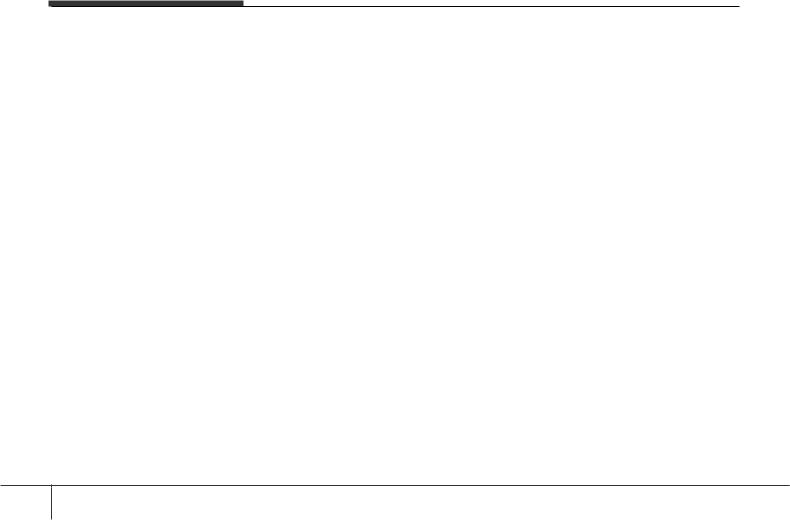
Introduction
VEHICLE HANDLING
INSTRUCTIONS
A090000AEN
As with other vehicles of this type, failure to operate this vehicle correctly may result in loss of control, an accident or vehicle rollover.
Specific design characteristics (higher ground clearance, track, etc.) give this vehicle a higher center of gravity than other types of vehicles. In other words they are not designed for cornering at the same speeds as conventional 2-wheel drive vehicles. Avoid sharp turns or abrupt maneuvers. Again, failure to operate this vehicle correctly may result in loss of control, an accident or vehicle rollover. Be sure to read the “Reducing the risk of a rollover” driving guidelines, in section 5 of this manual.
VEHICLE BREAK-IN PROCESS
A030000AUN
No special break-in period is needed. By following a few simple precautions for the first 1,000 km (600 miles) you may add to the performance, economy and life of your vehicle.
•Do not race the engine.
•While driving, keep your engine speed (rpm, or revolutions per minute) between 2,000 rpm and 4,000 rpm.
•Do not maintain a single speed for long periods of time, either fast or slow. Varying engine speed is needed to properly break-in the engine.
•Avoid hard stops, except in emergencies, to allow the brakes to seat properly.
•Don't tow a trailer during the first 2,000 km (1,200 miles) of operation.
1 6

|
|
|
|
|
|
Your vehicle at a glance |
|
2 |
|
|
|
|
|
|
|
|
Interior overview / 2-2 |
|
|
|
|
Instrument panel overview / 2-4 |
|
|
|
|
Engine compartment / 2-6 |
|
|
|
|
|
|
|
|
|
|
|
|
|
|
|
|
|
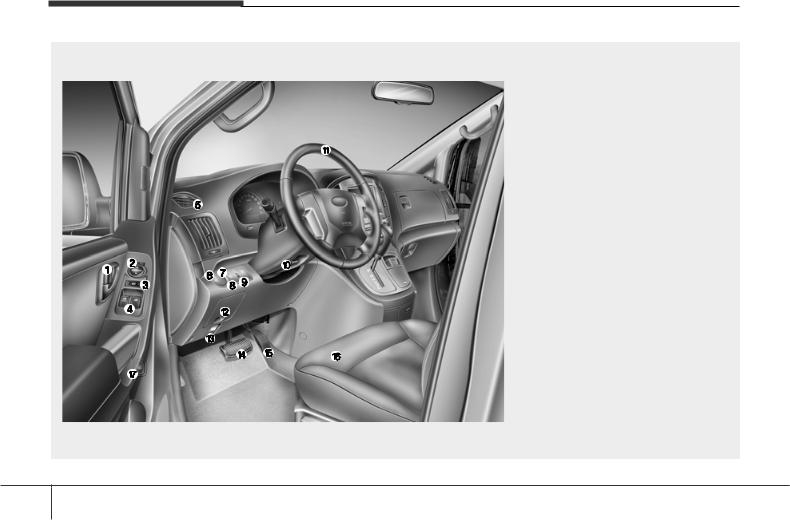
Your vehicle at a glance
INTERIOR OVERVIEW
Left-Hand drive type
1. |
Door lock/unlock button* ................... |
4-10 |
2. |
Outside rearview mirror control |
|
|
switch*............................................... |
4-30 |
3. |
Central door lock switch* .................. |
4-11 |
4. Power window switches*................... |
4-16 |
|
5. |
Air vent.............................................. |
4-63 |
6. |
Front fog light switch*........................ |
4-53 |
7. |
Rear fog light switch* ....................... |
4-53 |
8. |
Head lamp leveling device*............... |
4-54 |
9. |
Instrument panel illumination control |
|
|
knob*................................................. |
4-33 |
10. |
Steering wheel tilt control* .............. |
4-27 |
11. |
Steering wheel ................................ |
4-26 |
12. Fuse box ......................................... |
7-55 |
|
13. |
Hood release lever.......................... |
4-21 |
14. Brake pedal..................................... |
5-19 |
|
15. |
Accelerator pedal .............................. |
5-6 |
16. |
Seat................................................... |
3-2 |
17. |
Fuel filler lid release button............. |
4-23 |
* : if equipped |
|
|
OTQ027001G
B010000ATQ
2 2
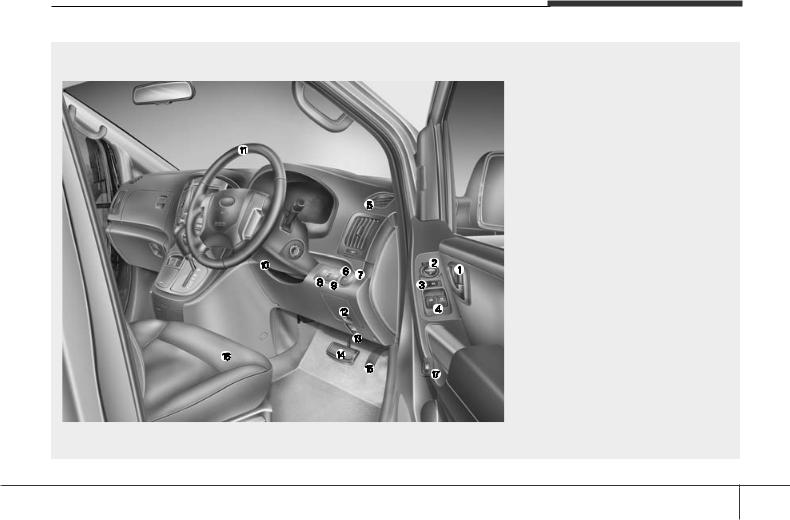
Your vehicle at a glance
Right-Hand drive type
1. |
Door lock/unlock button* ................... |
4-10 |
2. |
Outside rearview mirror control |
|
|
switch*............................................... |
4-30 |
3. |
Central door lock switch* .................. |
4-11 |
4. Power window switches*................... |
4-16 |
|
5. |
Air vent.............................................. |
4-63 |
6. |
Front fog light switch*........................ |
4-53 |
7. |
Rear fog light switch* ....................... |
4-53 |
8. |
Head lamp leveling device*............... |
4-54 |
9. |
Instrument panel illumination control |
|
|
knob*................................................. |
4-33 |
10. |
Steering wheel tilt control* .............. |
4-27 |
11. |
Steering wheel ................................ |
4-26 |
12. Fuse box ......................................... |
7-55 |
|
13. |
Hood release lever.......................... |
4-21 |
14. Brake pedal..................................... |
5-19 |
|
15. |
Accelerator pedal .............................. |
5-6 |
16. |
Seat................................................... |
3-2 |
17. |
Fuel filler lid release button............. |
4-23 |
* : if equipped |
|
|
OTQ027001R
B010000ATQ-EA
2 3
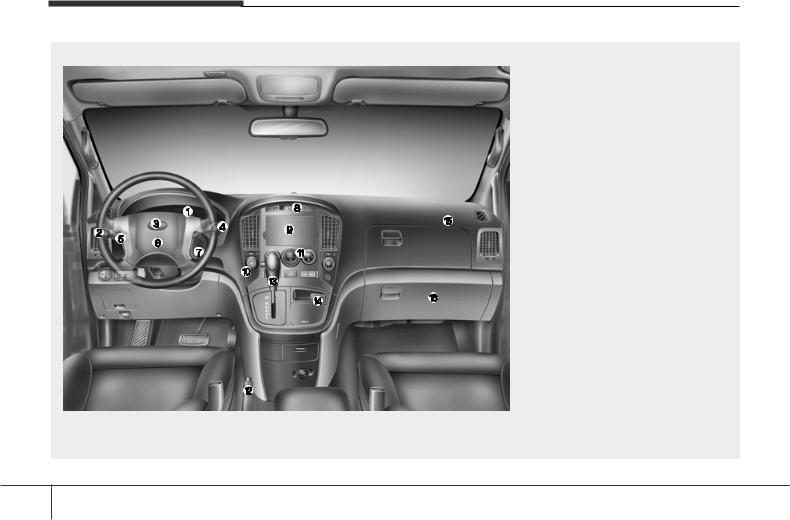
Your vehicle at a glance
INSTRUMENT PANEL OVERVIEW
Left-Hand drive type
1. |
Instrument cluster............................. |
4-32 |
2. |
Light control / Turn signals ............... |
4-50 |
3. Horn ................................................. |
4-27 |
|
4. Wiper/Washer................................... |
4-55 |
|
5. |
Steering wheel audio controls* ........ |
4-83 |
6. |
Driver’s front air bag* ....................... |
3-44 |
7. |
Ignition switch..................................... |
5-4 |
8. |
Digital clock* .................................... |
4-80 |
9. |
Audio*............................................... |
4-82 |
10. Hazard warning flasher |
|
|
|
switch ...................................... |
4-50, 6-2 |
11. |
Climate control system* ................. |
4-61 |
12. |
Parking brake ................................. |
5-20 |
13. |
Shift lever ................................ |
5-12, 5-9 |
14. AUX, USB and iPod port* .............. |
4-84 |
|
15. |
Passenger’s front air bag* .............. |
3-44 |
16. Glove box ....................................... |
4-74 |
|
* : if equipped |
|
|
OTQ027002G
B020000BTQ
2 4
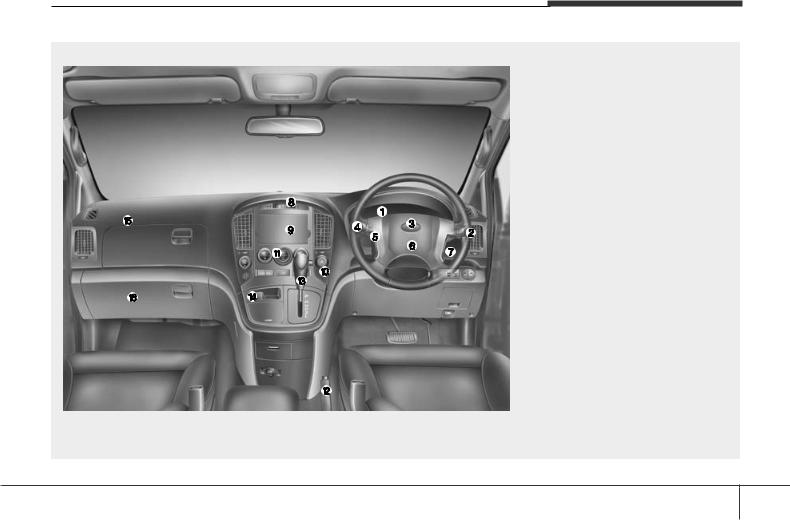
Your vehicle at a glance
Right-Hand drive type
1. |
Instrument cluster............................. |
4-32 |
2. |
Light control / Turn signals ............... |
4-50 |
3. Horn ................................................. |
4-27 |
|
4. Wiper/Washer................................... |
4-55 |
|
5. |
Steering wheel audio controls* ........ |
4-83 |
6. |
Driver’s front air bag* ....................... |
3-44 |
7. |
Ignition switch..................................... |
5-4 |
8. |
Digital clock* .................................... |
4-80 |
9. |
Audio*............................................... |
4-82 |
10. Hazard warning flasher |
|
|
|
switch ...................................... |
4-50, 6-2 |
11. |
Climate control system* ................. |
4-61 |
12. |
Parking brake ................................. |
5-20 |
13. |
Shift lever ................................ |
5-12, 5-9 |
14. AUX, USB and iPod port* .............. |
4-84 |
|
15. |
Passenger’s front air bag* .............. |
3-44 |
16. Glove box ....................................... |
4-74 |
|
* : if equipped |
|
|
OTQ027002R
B020000BTQ
2 5
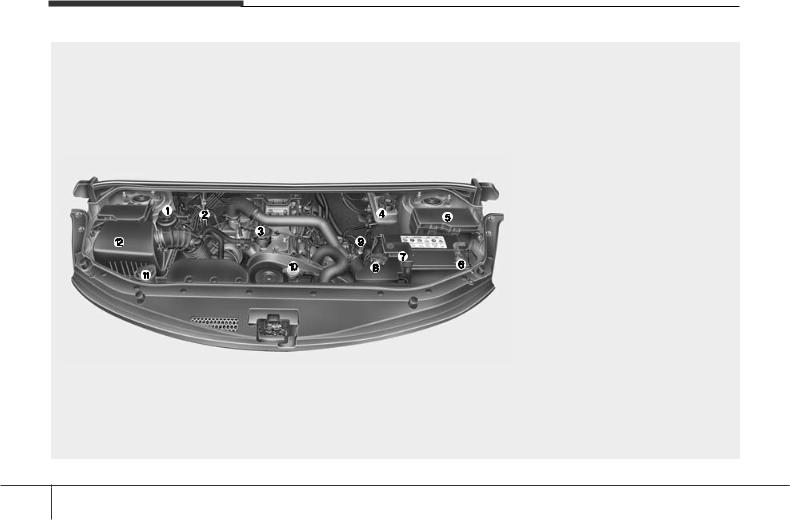
Your vehicle at a glance
ENGINE COMPARTMENT
1. |
Power steering fluid reservoir ........... |
7-30 |
2. |
Automatic transmission fluid |
|
|
dipstick*............................................. |
7-31 |
3. |
Engine oil filler cap ........................... |
7-25 |
4. |
Brake fluid reservoir.......................... |
7-29 |
5. Fuse box ........................................... |
7-56 |
|
6. |
Negative battery terminal.................. |
7-41 |
7. |
Positive battery terminal ................... |
7-41 |
8. |
Engine coolant reservoir ................... |
7-27 |
9. |
Engine oil dipstick ............................. |
7-25 |
10. Radiator cap ................................... |
7-28 |
|
11. Windshield washer fluid reservoir ... |
7-33 |
|
12. Air cleaner....................................... |
7-35 |
|
* : if equipped |
|
|
* The actual engine room in the vehicle may differ from the illustration.
OTQ077001
B030000ATQ
2 6

Seats / 3-2
Seat belts / 3-15
Child restraint system / 3-26
Air bag - supplemental restraint system / 3-38
|
Safety features of your vehicle |
|
3 |
|
|
|
|
|
|
|
|
|
|
|
|
|
|
|
|
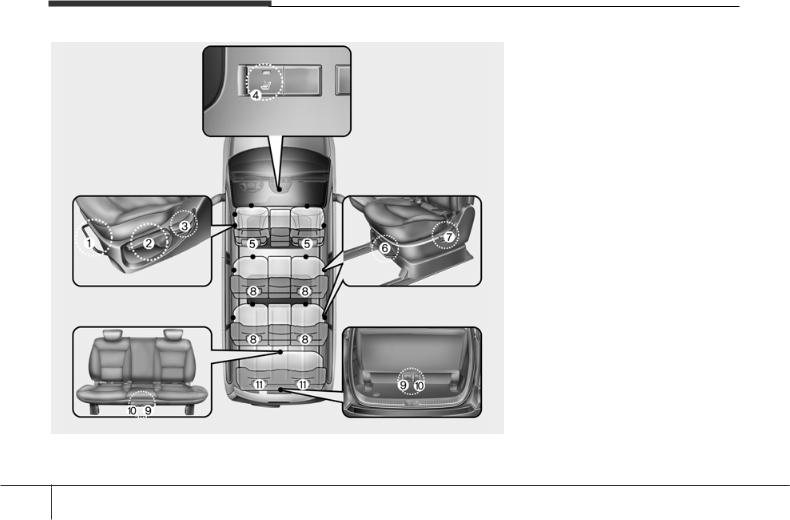
Safety features of your vehicle
SEATS
Front seat
(1) Forward and backward
(2) Seatback angle
(3) Seat cushion height (Driver’s seat)*
(4) Seat warmer (Driver’s seat)*
(5) Headrest
2nd row seat* / 3rd row seat*
(6) Forward and backward/
Seat rotation (2nd row seat only)*
(7) Seatback angle
(8) Headrest
4th row seat*
(9) Forward and backward
(10) Seat cushion folding
(11) Headrest
*: if equipped
OTQ037001E
C010000BTQ
The actual seats in the vehicle may differ from the illustration.
3 2
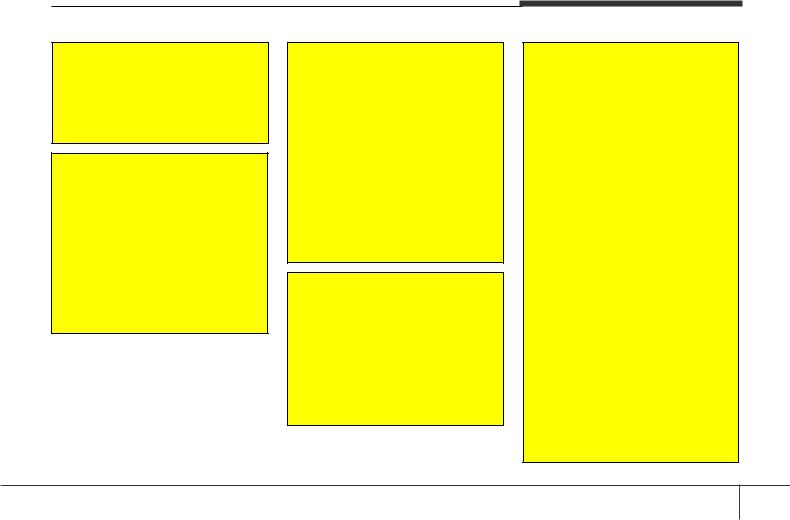
 WARNING - Loose objects
WARNING - Loose objects
Loose objects in the driver’s foot area could interfere with the operation of the foot pedals, possibly causing an accident. Do not place anything under the front seats.
 WARNING - Uprighting seat
WARNING - Uprighting seat
When you return the seatback to its upright position, hold the seatback and return it slowly and be sure there are no other occupants around the seat. If the seatback is returned without being held and controlled, the back of the seat could spring forward resulting in accidental injury to a person struck by the seatback.
 WARNING - Driver responsibility for passengers
WARNING - Driver responsibility for passengers
Riding in a vehicle with the seatback reclined could lead to serious or fatal injury in an accident. If a seat is reclined during an accident, the occupant’s hips may slide under the lap portion of the seat belt applying great force to the unprotected abdomen. Serious or fatal internal injuries could result. The driver must advise the front passenger to keep the seatback in an upright position whenever the vehicle is in motion.
 WARNING
WARNING
Do not use a sitting cushion that reduces friction between the seat and passenger. The passenger's hips may slide under the lap portion of the seat belt during an accident or a sudden stop. Serious or fatal internal injuries could result because the seat belt can't operate normally.
Safety features of your vehicle
 WARNING - Driver’s seat
WARNING - Driver’s seat
•Never attempt to adjust the seat while the vehicle is moving. This could result in loss of control, and an accident causing death, serious injury, or property damage.
•Do not allow anything to interfere with the normal position of the seatback. Storing items against a seatback or in any other way interfering with proper locking of a seatback could result in serious or fatal injury in a sudden stop or collision.
•Always drive and ride with your seatback upright and the lap portion of the seat belt snug and low across the hips. This is the best position to protect you in case of an accident.
•In order to avoid unnecessary and perhaps severe air bag injuries, always sit as far back as possible from the steering wheel while maintaining comfortable control of the vehicle. We recommend that your chest be at least 250 mm (10 inches) away from the steering wheel.
3 3
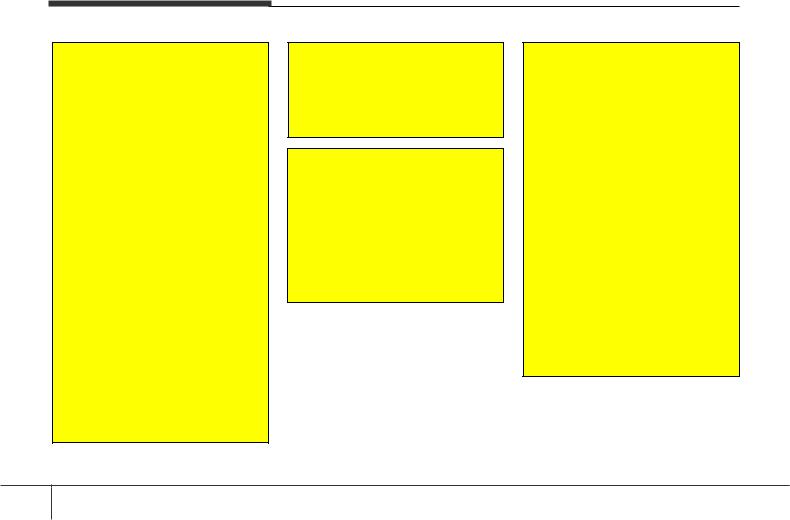
Safety features of your vehicle
 WARNING - Rear seatbacks
WARNING - Rear seatbacks
•The rear seatback must be securely latched. If not, passengers and objects could be thrown forward resulting in serious injury or death in the event of a sudden stop or collision.
•Luggage and other cargo should be laid flat in the cargo area. If objects are large, heavy, or must be piled, they must be secured. Under no circumstances should cargo be piled higher than the seatbacks. Failure to follow these warnings could result in serious injury or death in the event of a sudden stop, collision or rollover.
•No passenger should ride in the cargo area or sit or lie on folded seatbacks while the vehicle is moving. All passengers must be properly seated in seats and restrained properly while riding.
•When resetting the seatback to the upright position, make sure it is securely latched by pushing it forward and backwards.
(Continued)
(Continued)
•To avoid the possibility of burns, do not remove the carpet in the cargo area. Emission control devices beneath this floor generate high temperatures.
 WARNING
WARNING
After adjusting the seat, always check that it is securely locked into place by attempting to move the seat forward or backward without using the lock release lever. Sudden or unexpected movement of the driver's seat could cause you to lose control of the vehicle resulting in an accident.
 WARNING
WARNING
•Do not adjust the seat while wearing seat belts. Moving the seat cushion forward may cause strong pressure on the abdomen.
•Use extreme caution so that hands or other objects are not caught in the seat mechanisms while the seat is moving.
•Do not put a cigarette lighter on the floor or seat. When you operate the seat, gas may gush out of the lighter and cause fire.
•If there are occupants in the rear seats, be careful while adjusting the front seat position.
•Use extreme caution when picking small objects trapped under the seats or between the seat and the center console. Your hands might be cut or injured by the sharp edges of the seat mechanism.
3 4
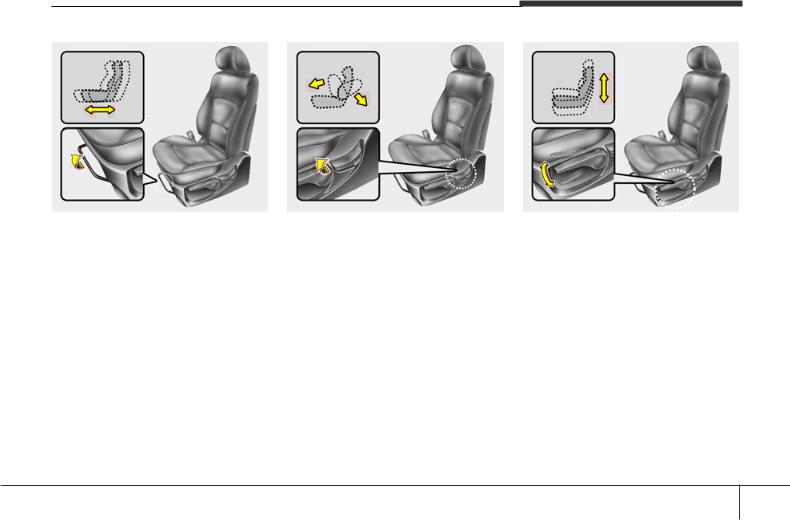
Safety features of your vehicle
OTQ037002
Front seat adjustment
C010101AUN
Forward and backward
To move the seat forward or backward:
1.Pull the seat slide adjustment lever under the front edge of the seat cushion up and hold it.
2.Slide the seat to the position you desire.
3.Release the lever and make sure the seat is locked in place.
Adjust the seat before driving, and make sure the seat is locked securely by trying to move forward and backward without using the lever. If the seat moves, it is not locked properly.
OTQ037003
C010102AUN
Seatback angle
To recline the seatback:
1.Lean forward slightly and lift up on the seatback recline lever located on the outside of the seat at the rear.
2.Carefully lean back on the seat and adjust the seatback of the seat to the position you desire.
3.Release the lever and make sure the seatback is locked in place. (The lever MUST return to its original position for the seatback to lock.)
OTQ037004
C010103AUN
Seat cushion height (for driver’s seat)
To change the height of the seat cushion, push the lever that is located on the outside of the seat cushion upwards or downwards.
•To lower the seat cushion, push the lever down several times.
•To raise the seat cushion, pull the lever up several times.
3 5
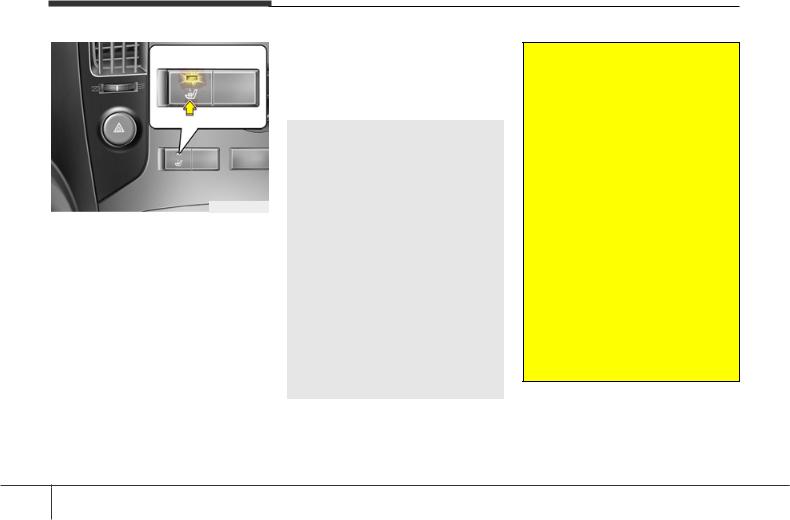
Safety features of your vehicle
OTQ037008E
C010107CTQ
Seat warmer
(Driver’s seat, if equipped)
The seat warmer is provided to warm the driver’s seat during cold weather. With the ignition switch in the ON position, push the switch to warm the driver's seat. During mild weather or under conditions where the operation of the seat warmer is not needed, keep the switch in the "OFF" position.
•The seat warmer defaults to the OFF position whenever the ignition switch is turned on.
NOTICE
With the seat warmer switch in ON position, the heating system in the seat turns off or on automatically depending on the seat temperature.
 CAUTION
CAUTION
•When cleaning the seats, do not use an organic solvent such as thinner, benzene, alcohol and gasoline. Doing so may damage the surface of the heater or seats.
•To prevent overheating the seat warmer, do not place anything on the seats that insulates against heat, such as blankets, cushions or seat covers while the seat warmer is in operation.
•Do not place heavy or sharp objects on seats equipped with seat warmer. Damage to the seat warming components could occur.
•Do not change the seat cover. It may damage the seat warmer or airventilation system.
 WARNING - Seat warmer burns
WARNING - Seat warmer burns
Passengers should use extreme caution when using seat warmers due to the possibility of excess heating or burns. The seat warmer may cause burns even at low temperatures, especially if used for long periods of time.
In particular, the driver must exercise extreme care for the following types of passengers:
1.Infants, children, elderly or handicapped persons, or hospital outpatients
2.Persons with sensitive skin or those that burn easily
3.Fatigued individuals
4.Intoxicated individuals
5.Individuals taking medication that can cause drowsiness or sleepiness (sleeping pills, cold tablets, etc.)
3 6
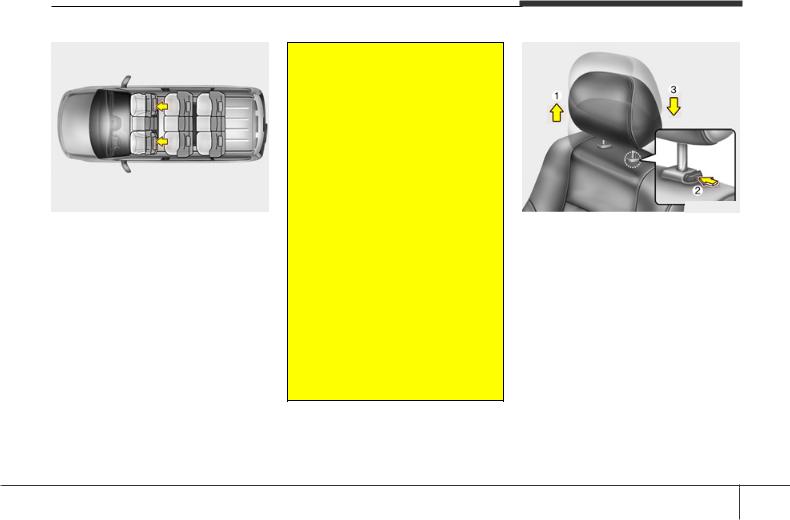
Safety features of your vehicle
OTQC031161E
C010104CTQ
Headrest
The driver's and front passenger's seats are equipped with a headrest for the occupant's safety and comfort.
The headrest not only provides comfort for the driver and front passenger, but also helps to protect the head and neck in the event of a collision.
 WARNING
WARNING
•For maximum effectiveness in case of an accident, the headrest should be adjusted so the middle of the headrest is at the same height of the center of gravity of an occupant's head. Generally, the center of gravity of most people's head is similar with the height of the top of their eyes. Also, adjust the headrest as close to your head as possible. For this reason, the use of a cushion that holds the body away from the seatback is not recommended.
•Do not operate the vehicle with the headrests removed as severe injury to the occupants may occur in the event of an accident. Headrests may provide protection against neck injuries when properly adjusted.
•Do not adjust the headrest position of the driver's seat while the vehicle is in motion.
OFD037037
Adjusting the height up and down
To raise the headrest, pull it up to the desired position (1). To lower the headrest, push and hold the release button (2) on the headrest support and lower the headrest to the desired position (3).
3 7

Safety features of your vehicle
OYFH034205
 CAUTION
CAUTION
If you recline the seatback towards the front with the head restraint and seat cushion raised, the head restraint may come in contact with the sunvisor or other parts of the vehicle.
OTQ033200
Removal
To remove the headrest:
1.Recline the seatback (2) with the recline lever (1).
2.Raise headrest as far as it can go.
3.Press the headrest release button (3) while pulling the headrest up (4).
 WARNING
WARNING
NEVER allow anyone to ride in a seat with the headrest removed.
OTQ033201
Reinstall
To reinstall the headrest :
1.Put the headrest poles (2) into the holes while pressing the release button
(1).
2.Recline the seatback (4) with the recline lever (3).
3.Adjust the headrest to the appropriate height.
 WARNING
WARNING
Always make sure the headrest locks into position after reinstalling and adjusting it properly.
3 8
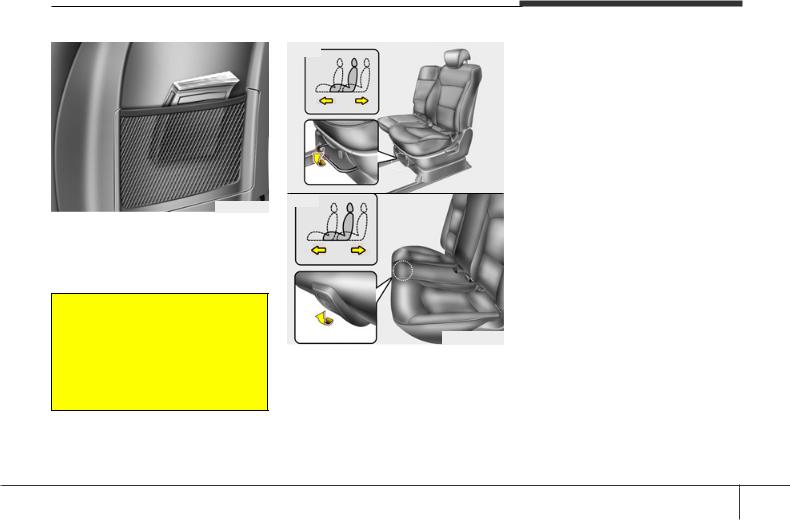
Safety features of your vehicle
OTQ037036
C010108AUN
Seatback pocket (if equipped)
The seatback pocket is provided on the back of the front passenger’s and driver’s seatbacks.
 WARNING - Seatback pockets
WARNING - Seatback pockets
Do not put heavy or sharp objects in the seatback pockets. In an accident they could come loose from the pocket and injure vehicle occupants.
Type A
OTQ037011
Type B
OTQ037011G
Rear seat adjustment
C010301ATQ
Forward and backward (2nd and 3rd row, if equipped)
To move the seat forward or backward:
1.Pull up the seat slide adjustment lever under the front edge of the seat cushion and hold it.
2.Slide the seat to the position you desire.
3.Release the lever and make sure the seat is locked in place.
Adjust the seat before driving, and make sure the seat is locked securely by trying to move forward and backward without using the lever. If the seat moves, it is not locked properly.
3 9
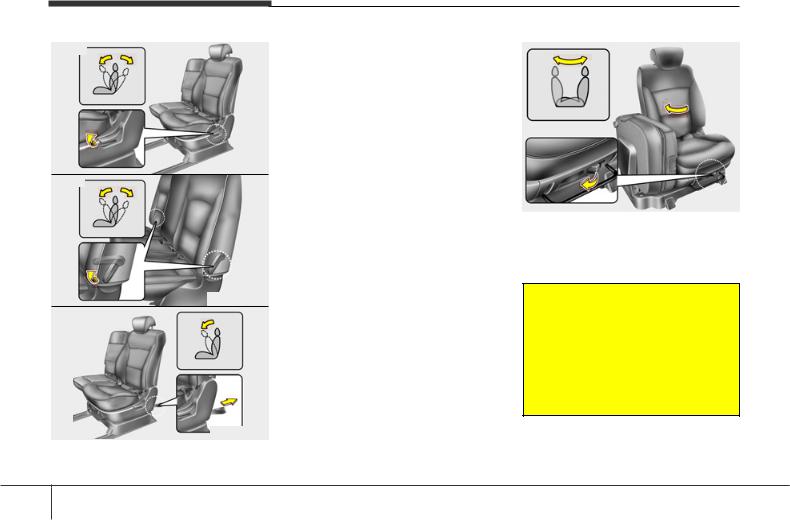
Safety features of your vehicle
Type A
OTQ037012
Type B
OTQ037012G
Type C
OTQ037015
C010302ATQ
Seatback angle (if equipped)
To recline the seatback:
1.Pull or pull up the seatback recline lever.
2.Carefully lean back the seat and adjust the seatback to the position you desire.
3.Release the lever and make sure the seatback is locked in place. (The lever MUST return to its original position for the seatback to lock.)
OTQ037033
Seat rotation
(2nd row seat, if equipped)
Pull the lever and rotate the seat clockwise.
 WARNING
WARNING
• Never rotate the seat while the vehicle is in motion.
• When the seat is rotated, be sure that the seat is securely locked in position. It not, it may result in serious injury in the event of a sudden stop.
3 10
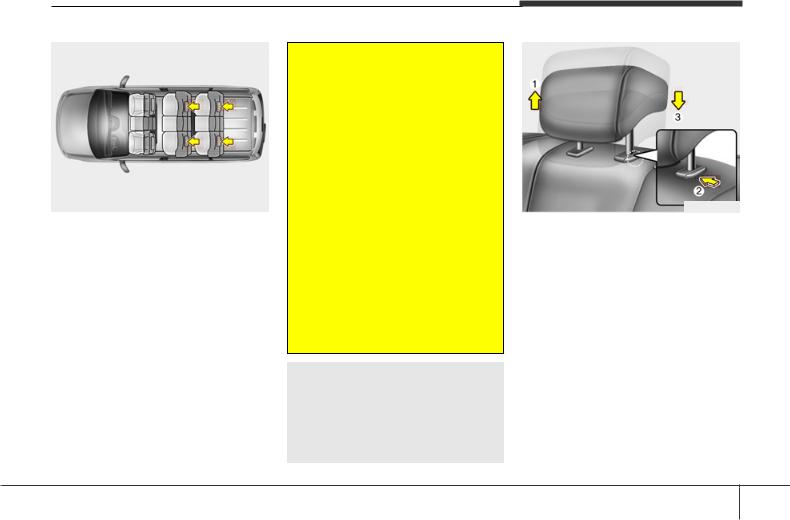
Safety features of your vehicle
OTQC031161F
C010303CTQ
Headrest
The rear seats are equipped with headrests in the outboard seating positions (except center seating position) for the occupant's safety and comfort.
The headrest not only provides comfort for passengers, but also helps to protect the head and neck in the event of a collision.
 WARNING
WARNING
•For maximum effectiveness in case of an accident, the headrest should be adjusted so the middle of the headrest is at the same height of the center of gravity of an occupant's head. Generally, the center of gravity of most people's head is similar with the height of the top of their eyes. Also, adjust the headrest as close to your head as possible. The use of a cushion that holds the body away from the seatback is not recommended.
•Do not operate the vehicle with the headrests removed as severe injury to an occupant may occur in the event of an accident. Headrests may provide protection against severe neck injuries when properly adjusted.
 CAUTION
CAUTION
When there is no occupant in the rear seats, adjust the height of the headrest to the lowest position. The rear seat headrest can reduce the visibility of the rear area.
OHM038017
Adjusting the height up and down
To raise the headrest, pull it up to the desired position (1). To lower the headrest, push and hold the release button (2) on the headrest support and lower the headrest to the desired position (3).
3 11
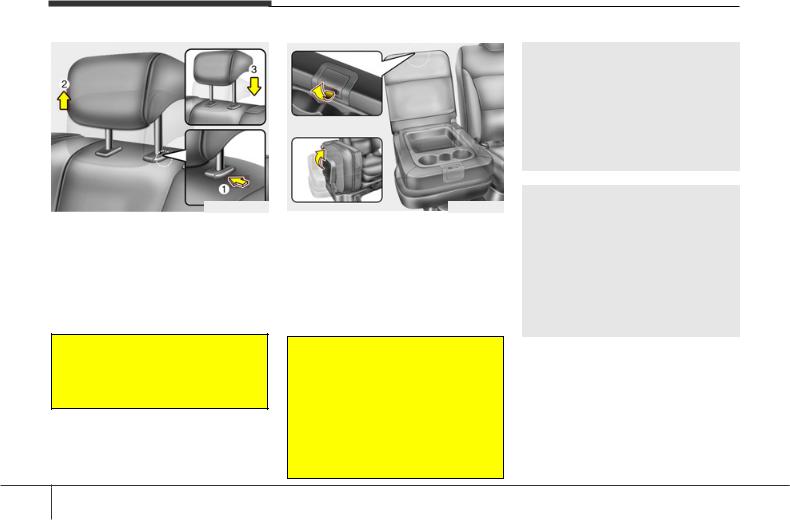
Safety features of your vehicle
OHM038018N
Removal
To remove the headrest, raise it as far as it can go then press the release button
(1) while pulling upward (2).
To reinstall the headrest, put the headrest poles (3) into the holes while pressing the release button (1). Then adjust it to the appropriate height.
 WARNING
WARNING
Make sure the headrest locks in position after adjusting it to properly protect the occupants.
OTQ037031
C010304ATQ
Center seat folding (if equipped)
1.Stow the rear seat belt in the pocket to prevent the seat belt from being damaged.
2.Pull the release knob and fold the seatback forward.
3.Fold up the seat.
 WARNING - Uprighting seat
WARNING - Uprighting seat
When you return the seatback to its upright position, hold the seatback and return it slowly. If the seatback is returned without holding it, the back of the seat could spring forward resulting in injury caused by being struck by the seatback.
CAUTION - Damaging rear seat belt buckles
When you fold the rear (2nd and/or 3rd row) seatback, insert the buckle in the pocket between the rear seatback and cushion. Doing so can prevent the buckle from being damaged by the rear seatback.
CAUTION - Rear seat belts
When returning the rear (2nd and/or 3rd row) seatbacks to the upright position, remember to return the rear shoulder belts to their proper position. Routing the seat belt webbing through the rear seat belt guides will help keep the belts from being trapped behind or under the seats.
3 12
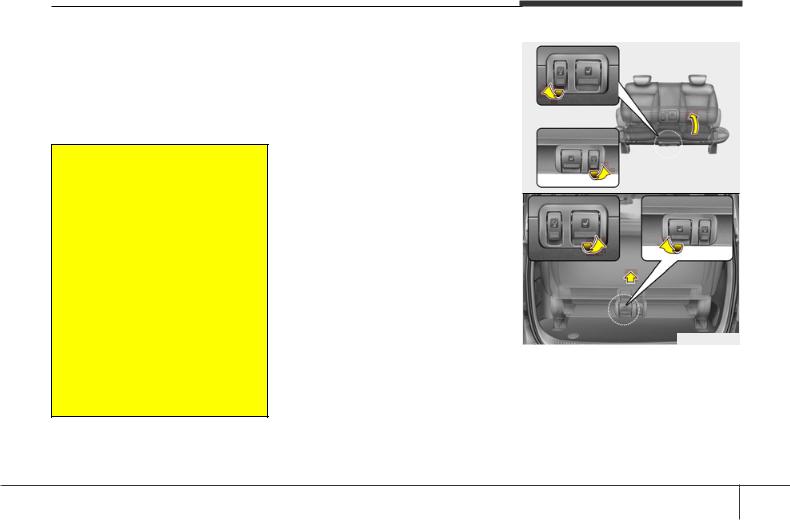
Safety features of your vehicle
C010307ATQ
Folding the rear seat
(4th row seat, if equipped)
The rear seat cushion may be folded to facilitate carrying long items or to increase the luggage capacity of the vehicle.
 WARNING
WARNING
The purpose of the fold rear seat is to allow you to carry longer objects that could not be accommodated in the cargo area.
Never allow passengers to sit on a improper position (ex : top of the folded seat, floor etc.) while the car is moving as this is not a proper seating position and no seat belts are available for use. This could result in serious injury or death in case of an accident or sudden stop. Objects carried on the cargo area should not extend higher than the top of the front seatbacks. Doing this could allow cargo to slide forward and cause injury or damage during sudden stops.
To fold the rear seat:
1.Stow the rear seat belt in the pocket to prevent the seat belt from being damaged.
2.Set the 3rd row seatback to the upright position and if necessary, slide the 3rd row seat forward.
OTQ037016
OTQ037017
3. Pull on the seatcushion folding lever, then fold the seat toward the rear of the vehicle.
4. Increase the luggauge compartment space by moving the rear seat using the sliding lever.
3 13
